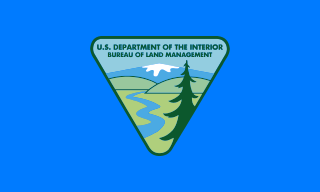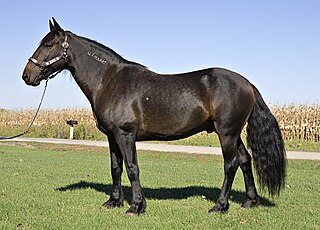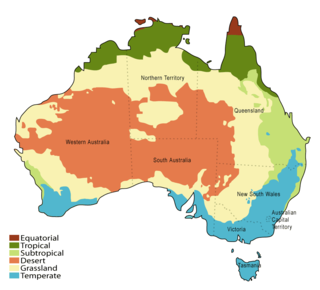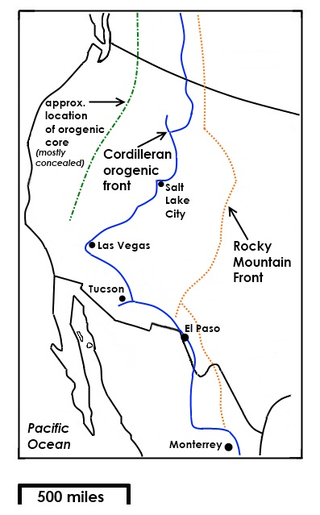Related Research Articles

Wyoming is a state in the Mountain West subregion of the Western United States. It is bordered by Montana to the north and northwest, South Dakota and Nebraska to the east, Idaho to the west, Utah to the southwest, and Colorado to the south. With a population of 576,851 in the 2020 United States census, Wyoming is the least populous state despite being the 10th largest by area, with the second-lowest population density after Alaska. The state capital and most populous city is Cheyenne, which had an estimated population of 63,957 in 2018.

The Great Plains, sometimes simply "the Plains", is a broad expanse of flatland in North America. It is located west of the Mississippi River and east of the Rocky Mountains, much of it covered in prairie, steppe, and grassland. It is the southern and main part of the Interior Plains, which also include the tallgrass prairie between the Great Lakes and Appalachian Plateau, and the Taiga Plains and Boreal Plains ecozones in Northern Canada. The term Western Plains is used to describe the ecoregion of the Great Plains, or alternatively the western portion of the Great Plains.

The Bureau of Land Management (BLM) is an agency within the United States Department of the Interior responsible for administering federal lands. Headquartered in Washington DC, and with oversight over 247.3 million acres (1,001,000 km2), it governs one eighth of the country's landmass.

Agriculture is a major industry in the United States, which is a net exporter of food. As of the 2017 census of agriculture, there were 2.04 million farms, covering an area of 900 million acres (1,400,000 sq mi), an average of 441 acres per farm.

The Interior Plains is a vast physiographic region that spreads across the Laurentian craton of central North America, extending along the east flank of the Rocky Mountains from the Gulf Coast region to the Arctic Beaufort Sea. In Canada, it encompasses the Canadian Prairies separating the Canadian Rockies from the Canadian Shield, as well as the Boreal Plains and Taiga Plains east of the Mackenzie and Richardson Mountains; while in the United States, it includes the Great Plains of the West/Midwest and the tallgrass prairie region to the south of the Great Lakes extending east to the Appalachian Plateau region.

The mustang is a free-roaming horse of the Western United States, descended from horses brought to the Americas by the Spanish. Mustangs are often referred to as wild horses, but because they are descended from once-domesticated animals, they are actually feral horses. The original mustangs were Colonial Spanish horses, but many other breeds and types of horses contributed to the modern mustang, now resulting in varying phenotypes. Some free-roaming horses are relatively unchanged from the original Spanish stock, most strongly represented in the most isolated populations.

Although Australia is mostly arid, the nation is a major agricultural producer and exporter, with over 325,300 employed in agriculture, forestry and fishing as of February 2015. Agriculture and its closely related sectors earn $155 billion-a-year for a 12% share of GDP. Farmers and grazers own 135,997 farms, covering 61% of Australia's landmass. Across the country there is a mix of irrigation and dry-land farming. The success of Australia to become a major agricultural power despite the odds is facilitated by its policies of long-term visions and promotion of agricultural reforms that greatly increased the country's agricultural industry.
The history of agriculture in the United States covers the period from the first English settlers to the present day. In Colonial America, agriculture was the primary livelihood for 90% of the population, and most towns were shipping points for the export of agricultural products. Most farms were geared toward subsistence production for family use. The rapid growth of population and the expansion of the frontier opened up large numbers of new farms, and clearing the land was a major preoccupation of farmers. After 1800, cotton became the chief crop in southern plantations, and the chief American export. After 1840, industrialization and urbanization opened up lucrative domestic markets. The number of farms grew from 1.4 million in 1850, to 4.0 million in 1880, and 6.4 million in 1910; then started to fall, dropping to 5.6 million in 1950 and 2.2 million in 2008.
The grain trade refers to the local and international trade in cereals and other food grains such as wheat, barley, maize, and rice. Grain is an important trade item because it is easily stored and transported with limited spoilage, unlike other agricultural products. Healthy grain supply and trade is important to many societies, providing a caloric base for most food systems as well as important role in animal feed for animal agriculture.

The Rocky Mountain Front is a somewhat unified geologic and ecosystem area in North America where the eastern slopes of the Rocky Mountains meet the plains. In 1983, the Bureau of Land Management called the Rocky Mountain Front "a nationally significant area because of its high wildlife, recreation, and scenic values". Conservationists Gregory Neudecker, Alison Duvall, and James Stutzman have described the Rocky Mountain Front as an area that warrants "the highest of conservation priorities" because it is largely unaltered by development and contains "unparalleled" numbers of wildlife.

Canada is one of the largest agricultural producers and exporters in the world. As with other developed nations, the proportion of the population agriculture employed and agricultural GDP as a percentage of the national GDP fell dramatically over the 20th century, but it remains an important element of the Canadian economy. A wide range of agriculture is practised in Canada, from sprawling wheat fields of the prairies to summer produce of the Okanagan valley. In the federal government, overview of Canadian agriculture is the responsibility of the Department of Agriculture and Agri-Food.

The Red Desert is a high-altitude desert and sagebrush steppe located in the south-central portion of the U.S. state of Wyoming, comprising approximately 9,320 square miles. Among the natural features in the Red Desert region are the Great Divide Basin, a unique endorheic drainage basin formed by a division in the Continental Divide, and the Killpecker Sand Dunes, the largest living dune system in the United States. In the 19th century, the Oregon, California, and Mormon Trails crossed the Continental Divide at South Pass, just north of the Red Desert. Today, busy Interstate 80 bisects the desert's southern region while gas field roads cross the desert.

The Pryor Mountain mustang is a substrain of mustang considered to be genetically unique and one of the few strains of horses verified by DNA analysis to be descended from the original Colonial Spanish horses brought to the Americas by the Spanish. They live on the Pryor Mountains Wild Horse Range located in the Pryor Mountains of Montana and Wyoming in the United States, and are the only mustang herd remaining in Montana, and one of sixteen in Wyoming. They are protected by the Wild and Free-Roaming Horses and Burros Act of 1971 (WFRHBA) and managed by the Bureau of Land Management (BLM), who has set the optimum herd number at 120 animals. Genetic studies have revealed that the herd exhibits a high degree of genetic diversity and a low degree of inbreeding, and BLM has acknowledged the genetic uniqueness of the herd. Pryor Mountain Mustangs are relatively small horses, exhibit a natural ambling gait, and domesticated Pryor Mountain mustangs are known for their strength, sure-footedness and stamina. The Pryor Mountains Wild Horse Range is one of the most accessible areas to view feral horse herds in the United States and tourism to the area has increased in recent years.
Agriculture in the Southwest United States is very important economically in that region.

The Vogt–Nunberg Farm is a site on the National Register of Historic Places located in Wibaux, Montana. It was added to the Register on April 10, 2008. The application papers state the farm "is an important example of an early twentieth century diversified farming operation in eastern Montana".
Wheat is produced in almost every state in the United States, and is one of the most grown grains in the country. The type and quantity vary between regions. The US is ranked fourth in production volume of wheat, with almost 50 million tons produced in 2020, behind only China, India and Russia. The US is ranked first in crop export volume; almost 50% of its total wheat production is exported.

Agriculture in Wales has in the past been a major part of the economy of Wales, a largely rural country that forms part of the United Kingdom. Wales is mountainous and has a mild, wet climate. This results in only a small proportion of the land area being suitable for arable cropping, but grass for the grazing of livestock is present in abundance. As a proportion of the national economy, the importance of agriculture has become much reduced; a high proportion of the population now live in the towns and cities in the south of the country and tourism has become an important form of income in the countryside and on the coast. Arable cropping is limited to the flatter parts and elsewhere dairying and livestock farming predominate.
Agriculture in Alaska faces many challenges, largely due to the climate, the short growing season, and generally poor soils. However, the exceptionally long days of summer enable some vegetables to attain world record sizes.

The Daniel Pond Farmhouse, also known as Eggleston Farm, is a limestone-walled home built in Rutland, Wisconsin in the 1840s. In 1980 the house was listed on the National Register of Historic Places.

Agriculture in Arizona is a notable sector in the state’s economy, contributing more than $23.3 billion in 2018. Arizona’s diverse climate allows it to export all sorts of commodities such as nuts, wheat, cotton, eggs, meat, and dairy to the United States and 70 other countries. In 2018, the state produced 455.7 million pounds (206.7 kt) of red meat and ranked 3rd in producing vegetables in the United States, occupying 26 million acres of land for farms and ranches combined.
References
- ↑ "EPA Region 8 (Mountains and Plains)". US Environmental Protection Agency . Retrieved 2011-12-06.
- 1 2 3 4 5 6 Foulke, thomas; Coupal, Taylor (December 2005). "Status of Agricultural Land in Wyoming". Western Regional Science Association.
- 1 2 3 "Wyoming Agriculture in the Classroom". Archived from the original on January 2, 2012. Retrieved 6 December 2011.
- ↑ "Wyoming Geography from NETSTATE" . Retrieved 29 November 2011.
- ↑ "US Forest Service - Caring for the Land and Serving People". Archived from the original on 8 July 1997. Retrieved 17 November 2011.
- ↑ O'Gara, Geoffrey (2004). "The Last Open Range". High Country News. 36 (4): 20.
- 1 2 3 4 5 Bureau of Land Management, Wyoming (2010). "2010 Annual Report".
{{cite journal}}: Cite journal requires|journal=(help) - ↑ Bureau of Land Management, Wyoming. "Wild Horse and Burro". Archived from the original on 14 February 2013. Retrieved 6 December 2011.
- 1 2 Wyoming Game and Fish Department, Wyoming (2009). "Wyoming Game and Fish Department Strategic Habitat Plan".
{{cite journal}}: Cite journal requires|journal=(help) - ↑ ThreadEx
- ↑ "NOWData - NOAA Online Weather Data". National Oceanic and Atmospheric Administration. Retrieved December 10, 2021.
- ↑ "Station: Cheyenne, WY". U.S. Climate Normals 2020: U.S. Monthly Climate Normals (1991-2020). National Oceanic and Atmospheric Administration. Retrieved December 10, 2021.
- ↑ "WMO Climate Normals for Cheyenne WSFO, WY 1961–1990". National Oceanic and Atmospheric Administration. Retrieved December 10, 2021.
- ↑ "U.S. Climate Normals Quick Access". National Oceanic and Atmospheric Administration. Retrieved August 15, 2022.
- ↑ "NOAA Online Weather Data". National Weather Service. Retrieved August 15, 2022.